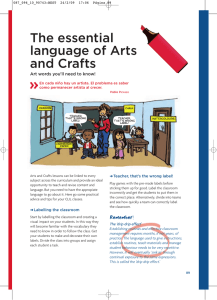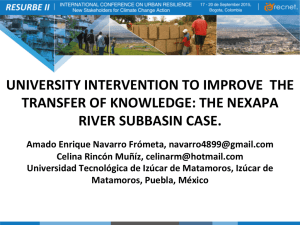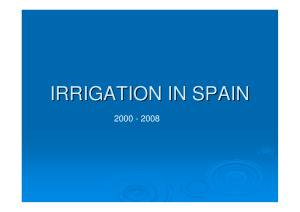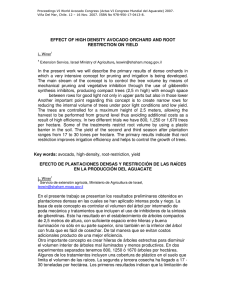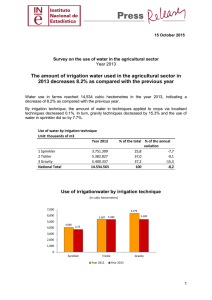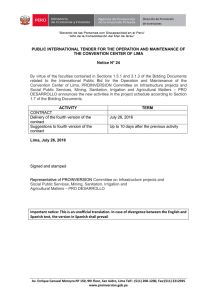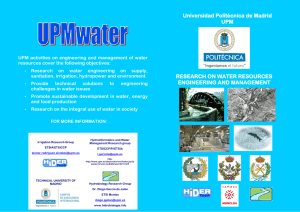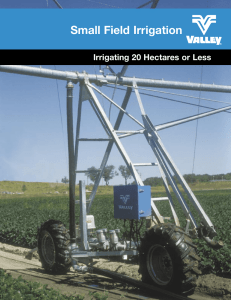Delivering the Truth. Dispelling the Myths.
Anuncio
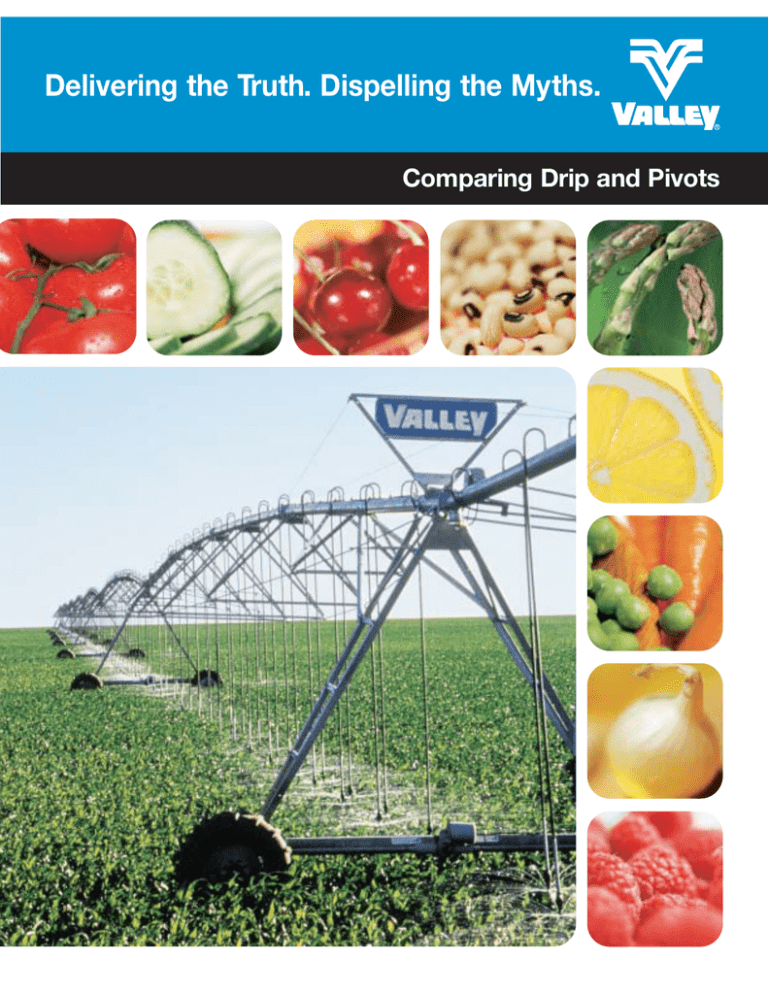
Delivering the Truth. Dispelling the Myths. Comparing Drip and Pivots In recent years, two effective and efficient irrigation methods have emerged as the leading technologies— center pivots and drip. People now associate distinct advantages and disadvantages with each. Some of these are true. Some are myths. So how do you make a decision between the two? You compare the facts. And there are at least five important areas where you should pay special attention: annual returns on assets initial investment costs labor costs water efficiency crop versatility After fully analyzing these issues, you’ll find that pivot irrigation is clearly the most advantageous in the majority of situations. And when it comes to center pivots, you won’t find better products than those from Valley. ® You Can’t Afford Not to Use Pivot Irrigation. Pivot installations and drip systems both have benefits. Drip irrigation makes good sense when your fields are small or irregularly shaped, or when you are growing trees over 16.4 ft (5 m) tall that pivots cannot fit over. But in most cases, financial analysis shows center pivots to be the logical choice for large-scale commercial agriculture. Simply put, if your crops benefit from pivot irrigation, so will your bottom line. Just look at the comparison in return on assets. It doesn’t take an accountant to see the advantages of center pivot irrigation equipment. Return on Assets Daniel O’Brien, Danny Rogers, Freddie Lamm, and Gary Clark. “An Economic Comparison of Subsurface Drip and Center Pivot Sprinkler Irrigation Systems.” Applied Engineering in Agriculture 14 (1998): 391-98. Center Pivots Cost Less, Last Longer, and Retain Their Value. When it comes to initial investment costs, center pivots are much less expensive than their drip irrigation counterparts. Center pivot irrigation equipment typically costs $245-$400/acre ($600$1000/ha). Drip systems cost between 20% to 100% more. Pivots also last twice as long — over 20 years for center pivots compared to a typical 10 years for drip systems. And even after 15 years, Valley® pivots retain 50% of their value for resale. Drip systems? After removing the tape, you probably have to pay someone to take it away. Mike Coggins, a Georgia vegetable grower and owner of both pivot and drip systems, on initial investment: “ There are certain crops where overhead irrigation is necessary...like carrots, green beans, and corn. With these crops, we harvest mechanically, and if we used drip, the irrigation system would be ruined by the machines. We have to manually harvest all of our crops grown with drip...The drip system is quite a bit more expensive than the pivots. It costs about $1100/acre ($2700/ha) to lay plastic and drip tape, another $200/acre ($495/ha) to remove it each year, plus $40/acre ($100/ha) more to have a waste company dispose of it. A pivot costs about $500/acre ($1235/ha) to install and then that’s it. ” Cut Labor Costs by Two-Thirds. Drip systems are notorious for the amount of labor required to operate and maintain them. It can take several hours to walk a field monitoring and maintaining the filters and lines. Not with center pivots. One person can run multiple machines covering thousands of acres/hectares using today’s computerized controls. And you don’t have to hire people to install and remove equipment season after season. Labor Costs Diogo Tudela, a Brazilian coffee grower and owner of both pivot and drip systems, on labor: “ Gordon Kruse, Dale Bucks, and R.D. Von Bernuth. “Comparison of Irrigation Systems.” In Irrigation of Agricultural Crops, ed. Stewart, B.A., and Donald R. Nielsen, 475-505. Madison, WI: American Society of Agronomy, 1990. I am not satisfied with the drip system at all. We always have problems. [My drip systems] require 100 times more labor than my pivots...I have different teams that run each irrigation system. For the pivots, I just ask where each pivot is and what section it has irrigated. It is quite simple. But for drip, the first question I ask every day is: ‘What problems do we have today?’ It is a rare and wonderful surprise if I am told that there are no problems. Usually our daily problems range from the weed cutters and laborers damaging the lines, to the groundhogs biting holes into the lines, to the lines being compressed by the soil and the sun. I will not buy another drip system. ” Pivots Don’t Just Save Money. They Save Water. One of the most prevalent misperceptions about mechanical move irrigation technology is that drip irrigation is far more water efficient than center pivots. Nothing could be further from the truth. In fact, they’re equally efficient with proper management. When it comes to comparing pivots to flood irrigation, the savings in water is remarkable: • 17.5 times the annual flow of the Nile. Total water saved by using Valley irrigation installations from1960 to 2002 — approximately 705 trillion liters. • 36 trillion liters. Amount of water Valley irrigation equipment saved in 2002 alone — more water than the Hoover Dam holds. Valmont estimate based on assumptions including a 750 GPM average for MMI and an 1,100 GPM average for flood, as well as the total water used for all Valmont installations between 1960 and 2002 amounting to 624.21 trillion liters. Don’t Waste Water. Use Wastewater. To help save your freshwater supply, center pivots are often used for controlled application of wastewater and nutrients on forage and grain crops. Because Valley pivots can handle solids, advanced filtration isn’t necessary. Applying wastewater through drip irrigation is much more complicated. Different tape with larger emitters and more filtration are needed, and plugging occurs much more frequently. Pivots. Proven to Work on Virtually Any Crop. Another misperception about pivots is that they’re only good for a few kinds of crops. And that’s precisely what that is — a misperception. It is true that certain crops must be grown using drip systems — especially those where the crop canopy is too high for pivots to cover, such as coconut trees and date palms. However, plenty of crops commonly associated with drip irrigation are just as well off, if not better off, with center pivots. Many are listed below. And when you consider the financial advantages of pivots, your choice is clear. Cotton Over 1,235,000 acres (500,000 ha) of cotton are irrigated with pivots in the United States alone, particularly in Texas, Arkansas, and Georgia, often using Low Energy Precision Application (LEPA) methods. Potatoes Potatoes are commonly irrigated with pivots in many parts of the world. In the Pacific Northwest and other parts of the United States, approximately 494,000 acres (200,000 ha) of potatoes are pivot irrigated. Sugar Cane Over 172,900 acres (70,000 ha) of sugar cane are irrigated with pivots in South Africa, Mauritius, Jamaica, Guatemala, Nicaragua, Argentina, Mexico, Brazil, and Australia. Only Buy Your Irrigation Equipment From Dealers You Can Trust. Some drip irrigation dealers have been known to get new customers in the door by bidding projects at an extremely low cost — sometimes as low as US $284/acre ($700/ha). However, at this cost, the design won’t function properly due to insufficient filtering, high-pressure loss in drip lines that are too long, or a combination of other design insufficiencies. Once the system is determined to be faulty, the dealer will suggest a few “upgrades.” Their cost adds up quickly, and the system becomes much more expensive than one that was properly designed from the start. If the price seems too good to be true, it probably is. Make sure your irrigation dealer has integrity and a good reputation. Comparing Drip and Pivots? There Is No Comparison. Initial Cost Plugging and Leaking • Pivots typically cost between $245-$400/acre ($600-$1000/ha). • Drip systems cost 20% to 100% more than pivots. • With a drip system, you must periodically apply chemicals to dissolve mineral concentration that can plug emitters. And you have to use herbicides to kill roots that could wrap themselves around water lines. • The aboveground sprinklers on a pivot are visible at all times, so plugging and leaking aren’t a problem. Maintenance Cost • The normal, annual cost to maintain a drip system is about 7-10% of the initial investment. • On a center pivot that’s used 2000 hours per year, the annual maintenance cost is about 1-2% of the original purchase price. Management • The 50,000 emitters on a 124 acre (50 ha) drip system requires considerably more dedicated management than center pivots. And that doesn’t even take into account the filter, drip lines, system controls, and higher pressure pump sets. • The 150 sprinklers on a 124 acre (50 ha) center pivot installation are easily maintained with a convenient system control. Design • The performance of a subsurface drip system is highly dependent on the skill and knowledge of the designer. • Pivot installations are fairly simple to design. Installation • Installing a drip system is difficult. You must choose tape depth carefully for compatibility with cultivation practices to ensure the drip tape isn’t damaged. • Pivot installation is an easy and standardized process. Filter Maintenance • You must constantly monitor drip system filters, then flush or change them when necessary to prevent significantly lower crop yields. • There is little or no filtering when using a pivot or linear. Germination • Subsurface drip systems can’t stimulate seed germination if the drip tape is placed below the root zone. • Water from sprinkler heads on a pivot comes down on soil like rain, causing seeds to germinate. In fact, pivots can easily be fitted with a dual sprinkler package — one for germination and one for irrigation. On the other hand, some drip irrigators also use sprinklers for germination. Life Span Salt Build-Up • Drip irrigation causes salt to accumulate at the dividing line between the irrigated zone and the non-irrigated zone in the soil, so that the soil becomes salinized over time. Eventually a sprinkler system will have to flush the accumulated salt below the crop root zone for the field to remain fertile. • Aboveground sprinklers distribute water evenly over the surface, which irrigates the crop and leaches the salts in the soil to below the root zone. Pests • Rats, crickets, corn borers, and mealy worms can attack vulnerable drip tape and cause leaks. You must dedicate a lot of time and money to combat these pests. • Pests cannot easily damage the steel structure and spray nozzles of a center pivot. Crop Rotation • With a drip system, crop rotation is difficult because of the predetermined row spacing. The optimum row spacing of one crop, such as watermelons 6’ (1.8 meters) is not ideal for a rotation crop such as cucumbers 3’ (.9 meters). Rotating cucumbers into a watermelon field will result in a yield loss. • With center pivots, you can easily rotate your crops as often as necessary, or your pivot circle can be segmented with different crops. Resale • You have to frequently replace drip tape, which is 20-25% of the total cost of a drip system. And once removed, it has no resale value whatsoever. In fact, removing the tape costs money. • Even after 15 years, a Valley pivot still holds a resale value of 50% of the initial purchase price. Environmental Impact • Typical drip tape lasts 5 years. After that, many drip irrigators have to contact hazardous materials experts for proper disposal of the used tape. • Valley equipment is made of 100% recyclable steel. • A typical drip system has a life span of approximately 10 years. • A typical Valley pivot has a life span of 20+ years. 7002 North 288 Street P.O. Box 358 Valley, Nebraska 68064-0358 USA Phone: 402-359-2201 (Ext. 3415) Fax: 402-359-4429 E-mail: [email protected] International: Ph: +1-402-359-6014 Fax:+1-402-359-4948 E-mail: [email protected] www.valmont.com Valmont® Irrigation has a policy of continuous product improvement and development. As a result, certain changes in standard equipment, options, price, etc., may have occurred after the publication of this catalog. Some photographs and specifications may not be identical to current production. Your local Valley® Dealer is your best source for up-to-date information. Valmont Irrigation reserves the right to change product design and specification at any time without incurring obligations. ©2003 Valmont Industries, Inc., Valley, NE 68064 USA. All rights reserved. AD10715 SS/JN 4/03
